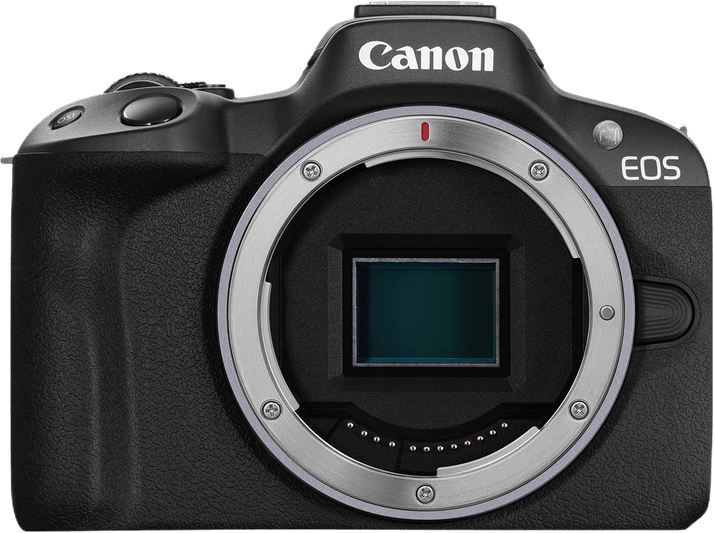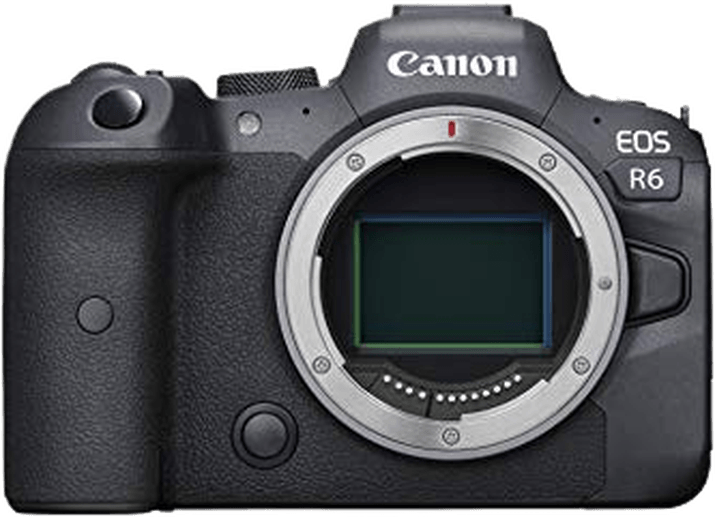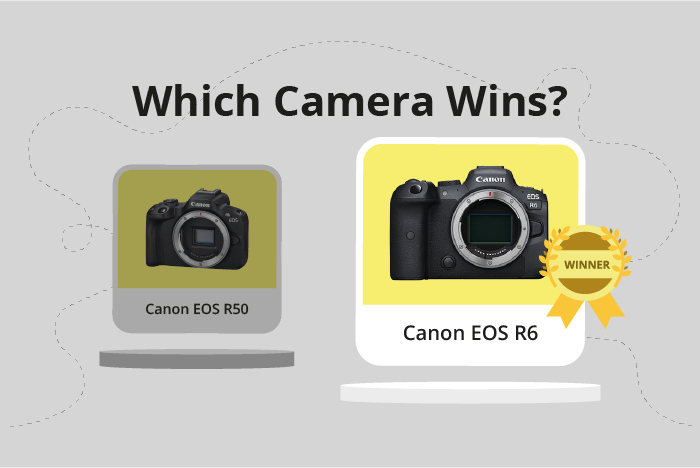Canon EOS R50 vs EOS R6 Comparison
Canon EOS R50

Canon EOS R6

The Canon EOS R6 takes the lead with a score of 80/100, while the Canon EOS R50 trails behind at 70/100. Both cameras are mirrorless and share similar features. However, the R6 outperforms the R50 in certain aspects, which contributes to its higher score.
The EOS R50, released in 2023, is a lighter and more compact camera, weighing 375g and measuring 116 x 86 x 69mm. It also boasts a lower launch price of $679, making it a more budget-friendly option.
On the other hand, the EOS R6, released in 2020, weighs 680g and measures 138 x 98 x 88mm. Despite its larger size and higher launch price of $2499, it offers superior performance and features, earning it a higher score.
Taking into account the specifications and scores, the Canon EOS R6 is a better camera for those looking for top-notch performance, while the Canon EOS R50 is a more affordable and lightweight option for casual photographers.
Canon EOS R50 vs EOS R6 Overview and Optics
The Canon EOS R6 outperforms the Canon EOS R50 in optics with a score of 79/100 compared to the R50’s 73/100. Both cameras share common specifications, such as having a CMOS sensor, a Digic X processor, and a Canon RF lens mount. However, the R6 has some advantages over the R50 that contribute to its higher score.
The R6 has a full-frame sensor, while the R50 has an APS-C sensor. This means the R6 can capture more light and produce better image quality, particularly in low-light situations. Additionally, the R6 has built-in image stabilization, which the R50 lacks. This feature allows for sharper images and smoother video recording, even when shooting handheld.
Despite having a lower megapixel count (20.1) compared to the R50’s 24 megapixels, the R6 compensates with a faster shooting speed of 20 frames per second. This makes the R6 more suitable for capturing fast-moving subjects and action photography.
On the other hand, the R50 has a higher DXOMARK score for its sensor (94) than the R6 (90), indicating slightly better overall sensor performance. However, this advantage may not be significant enough to outweigh the benefits of the R6’s full-frame sensor and image stabilization.
In comparing the optics of these two cameras, the Canon EOS R6 emerges as the superior choice due to its full-frame sensor, image stabilization, and faster shooting speed. While the Canon EOS R50 has a higher DXOMARK score and more megapixels, these factors do not make up for the R6’s advantages in most photography scenarios.
Canon EOS R50 vs EOS R6 Video Performance
The Canon EOS R50 and Canon EOS R6 both have a video score of 91/100, making them equal in this aspect. Both cameras share common video specifications, including 4K max video resolution, max video dimensions of 3840 x 2160, a max video frame rate of 120fps, and built-in time-lapse functionality.
The Canon EOS R50 does not have any distinct advantages in video capabilities over the Canon EOS R6, as they share the same specifications. This means that both cameras are equally suitable for capturing high-quality videos in various settings and conditions.
Similarly, the Canon EOS R6 does not possess any unique advantages in video capabilities over the Canon EOS R50. Both cameras are well-equipped to handle the same range of video tasks, providing users with the flexibility to capture stunning visuals without compromising quality.
Given that both cameras have identical video capabilities, the choice between the Canon EOS R50 and Canon EOS R6 will depend on other factors, such as price, design, and additional features. The equal video scores and shared specifications indicate that both cameras are excellent choices for videographers and photographers alike, offering high-quality video performance without any significant differences.
Canon EOS R50 vs EOS R6 Features and Benefits
The Canon EOS R6 outperforms the Canon EOS R50 with a feature score of 85/100, compared to the R50’s score of 72/100. Both cameras share several key specifications, including a 3-inch screen size, 1,620,000-dot screen resolution, touchscreen capabilities, flip screen functionality, and the absence of GPS. Additionally, both models offer WIFI and Bluetooth connectivity.
The Canon EOS R6 excels in certain aspects, contributing to its higher feature score. The R6’s advantages over the R50 include faster continuous shooting, better low-light performance, and a more advanced autofocus system. These attributes make the R6 a more versatile camera for various shooting conditions, such as action photography and low-light environments.
On the other hand, the Canon EOS R50 has a higher resolution sensor than the R6. This difference allows the R50 to produce images with more detail, which can be beneficial for landscape and studio photography. However, the R50’s higher resolution does not outweigh the advantages of the R6’s overall performance and features.
Considering each camera’s strengths and weaknesses, the Canon EOS R6 emerges as the superior option due to its faster continuous shooting, better low-light performance, and advanced autofocus system. The R50’s higher resolution sensor is a noteworthy advantage, but it does not compensate for the R6’s overall superiority. Therefore, the Canon EOS R6 is the better choice for most photographers, offering a more versatile and well-rounded feature set.
Canon EOS R50 vs EOS R6 Storage and Battery
The Canon EOS R6 outperforms the EOS R50 in storage and battery with a score of 68/100, compared to the R50’s 35/100. Both cameras accept SD, SDHC, and SDXC memory cards and offer USB charging. However, the R6 has two memory card slots, while the R50 has only one. Additionally, the R6 supports the faster UHS-II cards, ensuring quicker data transfer.
The R50’s battery life is slightly longer at 370 shots, compared to the R6’s 360 shots. However, the R6 uses the more powerful LP-E6NH battery, providing better overall performance. Despite the R50’s marginally longer battery life, the R6’s superior storage capabilities and battery type make it the better choice in this category.
Considering the storage and battery aspects, the Canon EOS R6 proves to be a superior camera, with its dual memory card slots, faster card compatibility, and more robust battery. The R50’s advantage in battery life is minimal and doesn’t outweigh the R6’s storage and battery benefits.
Canon EOS R50 vs EOS R6 – Our Verdict
Are you still undecided about which camera is right for you? Have a look at these popular comparisons that feature the Canon EOS R50 or the Canon EOS R6:

